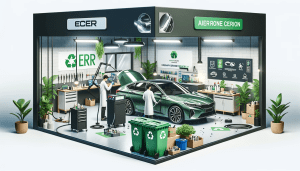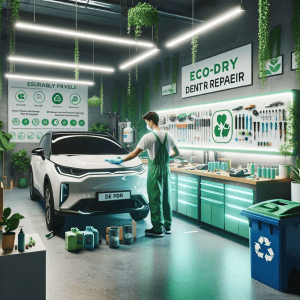
PDR Method (Paintless Dent Repair)
Today, there is an increasing emphasis on the need for ecological practices in all aspects of daily life, including the automotive repair industry. Traditional dent repair methods often involve the use of paint and thinners, which can have serious negative effects on the environment. In this context, the paintless dent repair method, also known as PDR (Paintless Dent Repair), offers significant ecological benefits.
The PDR method is an innovative approach that allows for the removal of small dents and irregularities on a car’s bodywork without the need for repainting. This process not only saves time and money but also reduces the ecological footprint of repair activities by avoiding the use of harmful chemicals.
At the beginning of the 21st century, as global efforts for environmental protection intensified, the automotive industry faced the challenge of finding greener solutions for routine operations such as bodywork repair. According to a study by the United States Environmental Protection Agency, traditional body repair methods can contribute to the annual release of over 1.5 million pounds of volatile organic compounds (VOCs) into the atmosphere, a significant factor in air pollution.
PDR offers an alternative that circumvents these harmful processes. Using specialized tools and techniques, PDR specialists can ‘massage’ the metal from behind the dent or use adhesive techniques from the front to restore the bodywork’s surface to its original state. This approach is not only more environmentally friendly but also preserves the car’s original coating, which can be essential for maintaining its value.
In the following sections of the article, we will examine in detail how the PDR technique saves resources and energy, reduces chemical waste, and contributes to sustainable development in the automotive industry, and how these practices fit into broader environmental protection goals.
The Ecological Advantages of the PDR Method (Paintless Dent Removal)
The process of PDR represents a cutting-edge achievement in the automotive industry, not only because of its efficiency but also due to its significantly lesser environmental impact compared to traditional dent repair methods. At the heart of this technique are specialized tools that allow technicians to access the back of dents and remove them, thereby leaving the factory coating intact. This eliminates the need to apply additional layers of paint and use thinners, which can lead to the release of harmful Volatile Organic Compounds (VOCs) into the atmosphere.
One of the most important techniques in PDR is the use of LED or UV lighting, which aids in the detailed visualization of the dent and allows technicians to work with high precision. Additionally, the use of wireless tools and damage assessment applications further reduces the energy footprint of repair procedures.
Furthermore, the PDR technique is favored for its ability to preserve the car’s original varnish, which often contains UV protection components and is designed to withstand extreme weather conditions. Preserving the original coating is vital not only for protecting the bodywork but also for maintaining the vehicle’s high value in the secondary market.
Investment in PDR equipment and training pays off not only by improving the quality of repairs but also by offering significant long-term environmental benefits. This makes the PDR method appealing both for services and for vehicle owners who aspire to environmentally responsible behavior.
In the next part of the article, we will examine in detail the environmental impact of traditional repair methods and how PDR offers a sustainable alternative that supports efforts to reduce the ecological footprint in the automotive industry.
Environmental Impact of Traditional Dent Repair
When it comes to vehicle dent repair, the traditional approach often involves the use of filler, putty, sanding, and painting. Each of these processes carries a considerable ecological burden. For example, paint products contain Volatile Organic Compounds (VOCs), which are among the major contributors to atmospheric pollution and can contribute to photochemical smog. According to data from the European Environment Agency, VOCs are among the primary pollutants to be controlled to improve air quality.
Furthermore, traditional repair requires a significant amount of energy to dry paints and fillers, as well as to operate ventilation systems necessary to remove toxic fumes from the work environment. These activities lead to high electricity consumption and, indirectly, to increased carbon emissions, especially if the electricity is generated from coal-fired power plants.
The Ecological Advantages of Choosing PDR


On the other hand, the PDR method offers a much cleaner and more energy-efficient alternative. As PDR does not use paints, thinners, or fillers, the reduction in VOCs is considerable. This method avoids the entire painting process, which not only saves time but also eliminates the need for drying in special booths, thereby reducing energy consumption.
Additionally, the tools used in PDR are manual or battery-operated, meaning lower energy consumption compared to the electric sanders used in traditional repair. Moreover, PDR preserves the integrity of the vehicle’s original coating, meaning that there is no need to produce and apply new paints and coatings.
Thus, PDR becomes a method that is not only faster and less costly, but also significantly better for the environment. This is particularly important in the context of the growing public awareness of ecological issues and the search for sustainable practices in all aspects of life, including vehicle maintenance and repair.
In the next part of the article, we will explore in more detail how PDR helps to reduce chemical waste and how this fits into global efforts to reduce the ecological footprint and achieve sustainable development goals.
Less Waste and More Energy Efficiency
The benefits of PDR extend beyond just reducing chemicals and pollutants. As the process uses fewer materials, it leads to the production of less waste and greater energy efficiency. Traditional dent repair requires the use of paint and body materials, which, over time, need to be disposed of, creating hazardous waste. This waste not only contributes to landfill pollution but also releases toxic chemicals during its decomposition […] .
Extending the Life of the Vehicle
Opting for PDR instead of traditional dent repair can help extend the life of your vehicle. Traditional methods involve sanding and scraping the bodywork, making it vulnerable to rust and other surface damage. This can reduce the structural integrity of the car and spoil its external appearance. PDR preserves the original appearance and structural integrity of the vehicle without long-term damage. Moreover, the method retains the original parts of the car, thereby avoiding the need to produce new components or materials. This helps to reduce the ecological damage caused by automotive production while preserving the vehicle’s value […].
In the next part of the article, we will explore how these ecological benefits of PDR are reflected in the automotive industry as a whole and how they support global sustainable development goals.
The Ecological Advantages of the PDR Method in the Context of the Automotive Industry


Choosing technologies and practices that reduce the ecological footprint is crucial for the automotive industry. The sector strives to meet increasingly strict environmental standards and satisfy a growing consumer demand for sustainable solutions. In this context, the PDR method offers not only an alternative to traditional repair methods but also highlights the automotive services’ commitment to ecological responsibility.
According to research, repair shops that implement PDR can achieve a significant reduction in waste and chemical use. This has a direct impact not only on local pollution but also on global efforts to combat climate change. By avoiding VOC emissions, typical of traditional repair methods, PDR contributes to improving air quality and reducing the potential for ozone formation in the lower layers of the atmosphere, a key factor for public health and the environment.
Furthermore, PDR enhances the energy efficiency of repair operations. As it does not require processes such as sanding, painting, and drying, which traditionally demand significant amounts of energy, services offering PDR can reduce their dependence on electricity and lower their operational costs.
The Role of PDR in Sustainable Development
The adoption of PDR is also important for supporting sustainable development in the automotive industry. By preserving the original components and materials, PDR helps to reduce the need for new production and, consequently, to decrease carbon emissions associated with the production process. This also helps to reduce the need for exploiting new resources, which can have a significant impact on reducing the ecological damage caused by the automotive industry.
Conclusion
The use of PDR offers numerous ecological benefits, which are crucial for improving sustainability in the automotive industry.



